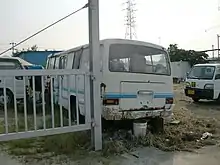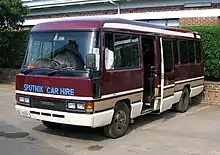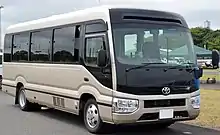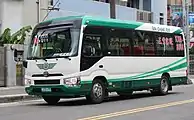Toyota Coaster
The Toyota Coaster (Japanese:トヨタ・コースター, Toyota Kōsutā) is a single-decker minibus produced by Toyota Motor Corporation. It was introduced in 1969, with the second generation introduced in 1982, followed by the third generation in 1993 and the fourth generation in late 2016. In Japan, the Coaster is sold exclusively at Toyota Store dealerships. Since 1996, the Toyota Coaster is also sold under the name Hino Liesse II.[3][4]
| Toyota Coaster | |
|---|---|
 Toyota Coaster GX (XZB70) | |
| Overview | |
| Manufacturer | Toyota Motor Corporation |
| Also called |
|
| Production | 1969–present |
| Assembly |
|
| Body and chassis | |
| Class | Minibus |
| Body style | Single-decker minibus |
| Layout | Front-engine, rear-wheel-drive / four-wheel drive |
| Floor type | Step entrance |
| Chassis | SWB/LWB/SLWB |
| Powertrain | |
| Engine |
|
| Capacity | 8–30 |
| Transmission | |
| Dimensions | |
| Length | 6,200–7,725 mm (244.1–304.1 in)[1][2] |
| Width | 2,000 mm (78.7 in) |
| Height | 2,600 mm (102.4 in) |
| Curb weight | 2,575–3,745 kg (5,677–8,256 lb) |
In Japan, the Coaster was formerly produced by Toyota Auto Body at its Yoshiwara plant.[5] In December 2016, after the launching of a revised Coaster, production was transferred to the Honsha plant of a Toyota Auto Body subsidiary, Gifu Auto Body.[6]
A number of unlicensed clones of third generation Coasters have been (and are still) made in China, including Jiangnan Motors' JNQ5041/JNQ6601,[7][8] Joylong Motors' HKL6700,[9] Golden Dragon's XML6700[10] and Sunlong Bus' SLK6770.[11]
History

The Toyota Coaster was introduced in 1969 as a 17-passenger minibus using the same running gear as the Toyota Dyna of the time. Early models used the 2.0-liter Toyota R engine with a 4-speed manual transmission. With its engine rated at 98 PS (72 kW), a RU19 Coaster could attain a top speed of 110 km/h (68 mph).[12] Subsequent models used a variety of four and six-cylinder diesel and petrol engines, and an option of automatic transmission was later introduced. A smaller alternative was later introduced at Toyopet Store locations, based on the Toyota ToyoAce called the Toyota HiAce which had the ability to carry up to 10 passengers but complied with Japanese Government regulations concerning exterior dimensions and engine displacement.
In August 1997, Toyota "Coaster Hybrid EV" minibus was launched, ahead of the Prius. The Coaster Hybrid, according to Toyota, became its first production hybrid vehicle.[13] Production of the Coaster Hybrid continued until 2007.
The LPG Coaster, fueled by liquefied petroleum gas, was developed specifically for the Hong Kong market and its air pollution problems.[14]
The Coaster is widely used in Singapore, Japan, Hong Kong, and Australia, but also in the developing world for minibus operators in Africa, the Middle East, South Asia, the Caribbean, Santa Cruz de la Sierra, Bolivia, Panama, and Peru as public transportation. It is the almost the only used mini bus in public transportation in Jordan and the brand is used to refer to that segment by people and even by the government. These buses are imported mainly from Asia and have the steering wheel moved to the left and the passenger door to the other side.
First generation (U10/B10)
.jpg.webp)

The Coaster was introduced in February 1969 in 22 and 26-seat models using the Dyna's U platform. It had the 1,994 cc (2.0 L) 5R petrol engine and the 2,481 cc (2.5 L) 2J diesel engine and was sold with the model code of RU18 and JU18. All models had a 4-speed manual gearbox with column shift. Air conditioning was available as an option on the deluxe models.[15]
In February 1972, the 2J engine was replaced by the 2,997 cc (3.0 L) diesel B engine, which was only available with a 5-speed manual gearbox with column shift. The updated models were sold with the model codes of RU19 and BU19.[15]
In August 1977, the Coaster's model platform code was changed to the B series, although the vehicle itself was mostly unchanged. The RB10 had the same 5R petrol engine as before but RB11 a 2,189 cc (2.2 L) 20R petrol engine was introduced. The B diesel engine was dropped and the 3,168 cc (3.2 L) 2B diesel engine was introduced on the B10. 21 and 25-seat models were available in addition to the previous 22 and 26-seat models. A high–roof model was added.[15]
In November 1979, column shift gearbox selection was dropped. All gearboxes were henceforth floor shifted. The 5R petrol engine was also dropped. The front grill received a mild face lift.[15]
In August 1980, the 2,366 cc (2.4 L) 22R petrol engine was introduced on the RB13 model.[15]
Second generation (B20/B30)


In May 1982 the Coaster received a major update to its body. It now had a wraparound front windscreen and thicker rear pillars. For the high-roof models, the 2-piece folding passenger door was replaced with a single piece door. The 20R petrol engine was dropped and the 2B diesel engine was replaced with the 3,431 cc (3.4 L) 3B diesel engine for the BB20. The 22R engine continued on the RB20. It was available in 16, 17, 20, 21, 22 and 26-seat models.[15][16]
Third generation (B40/B50)


In January 1993, the body was made more aerodynamic.[17]
Engines were the 4.2-litre 1HD-T turbocharged diesel, the 4.2-litre 1HZ diesel and the 3.4-litre 3B diesel.[17]
In November 1995, the 4WD BB58 was added. The 4.1-litre 15B-F diesel engine was introduced.[17]
In August 1997, a series hybrid EV model was added using a 1.5-litre engine.[17]
The third generation Coaster received a facelift in 2001, and again in 2007.
Fourth generation (B60/B70)


The fourth generation Toyota Coaster was unveiled on 22 December 2016[18] and was made available for purchase in Japan on 23 January 2017. It is available with the same engine choices as the outgoing model. The Coaster was the first vehicle to undergo a full redesign under Toyota's newly incorporated Commercial Vehicle (CV) company responsible for the design and development of commercial vehicles. The fourth generation Coaster incorporates many safety features as standard including air-bags for the driver and front passenger, Vehicle Stability Control (VSC), a ringed frame body for increased roll-over protection, pre-tensioners for the seat belts and force limiters which reduce the pressure on the passenger's chest in the event of a collision.
The height was increased by 60 mm (2.4 in), the width was increased by 40 mm (1.6 in) and the window height was increased by 50 mm (2.0 in) over the outgoing model. The door step were also lengthened by 65 mm (2.6 in) for easier entry and exit. The body was designed in a square shape for a more spacious seating space. The windshield was widened for increased outward visibility. The Coaster is available in three configurations; the standard wheelbase configuration can seat 25 passengers, the long wheelbase configuration can either seat 24 or 29 passengers while a school bus configuration can seat 3 adults and 49 children. The school bus configuration does not have a front passenger seat.[19][20]
Variants
- BB10 – 2B engine – First Generation diesel, 22–25 passengers[21]
- RB20 – 22R 2.4-litre petrol engine, 26 passengers
- BB21/BB22/BB23 – 3B/13B/14B 4-cyl engine, 26 passengers (1981–1993)
- HB30 – 2H Engine, 30 passengers
- HB31 – 12H-T turbo engine for EX models, sliding door (1981–1990)
- HDB30 – 1HD-T turbo engine for EX models (1989–1993)
- HZB30 – 1HZ engine, 30 passengers (1990–1993)
- BB40 – 3B engine, 26 passenger (1993–2003)
- HZB40 – 1HZ engine, 26 passengers
- HZB50 – 1HZ engine, 30 passengers (1993–2016)
- HZB51 – 1HZ turbo engine, Intercooler 30 passengers (1993–2012)
- HDB50 – 1HD turbo engine, non airbag suspension (1993–2003)
- HDB51 – 1HD turbo engine, airbag suspension (1993–2003)
- BB50 – 15B-FTE 4-cyl turbo intercooled engine, 6-speed manual or auto (2003–2006)
- XZB50/XZB51/XZB56 - Hino N04C 4-cyl turbo intercooled engine (2004–2016)
- BB58 – 15B (1997–1999) / 15B-FT (1999–2004) 4x4 factory built, uses Mega Cruiser's transmission and front portal axle differentials
Gallery
.jpg.webp) Toyota Coaster 1st generation
Toyota Coaster 1st generation Toyota Coaster 2nd generation
Toyota Coaster 2nd generation Toyota Coaster 3rd generation (pre-facelift, with round headlamps)
Toyota Coaster 3rd generation (pre-facelift, with round headlamps) Toyota Coaster 3rd generation (4WD, BB58, pre-facelift, with rectangular headlamps)
Toyota Coaster 3rd generation (4WD, BB58, pre-facelift, with rectangular headlamps) Toyota Coaster 3rd generation (2001 facelift)
Toyota Coaster 3rd generation (2001 facelift) Toyota Coaster 3rd generation (2001 facelift, low roof)
Toyota Coaster 3rd generation (2001 facelift, low roof)_15-05-2019.jpg.webp) Toyota Coaster 3rd generation (2007 facelift)
Toyota Coaster 3rd generation (2007 facelift) Toyota Coaster LPG 3rd generation (2007 facelift)
Toyota Coaster LPG 3rd generation (2007 facelift) Toyota Coaster 4th generation
Toyota Coaster 4th generation Toyota Coaster LPG 4th generation
Toyota Coaster LPG 4th generation
Conversions
The Toyota Coaster is used for motor home conversions. Retired Coasters are converted for home use by removal of most of the passenger seats, and the addition of beds, kitchens, TV, sink, water tanks, annexes and other fixtures.[22]
See also
References
- "Toyota Coaster Specs". Toyota Australia. Retrieved 22 April 2012.
- "Coaster Bus". Hong Kong: Crown Motors. Retrieved 24 July 2019.
- "Hino Liesse II". Hino. Retrieved 20 May 2020.
- "Hino Bus". Hino Thailand. Retrieved 20 May 2020.
- "Affiliates (Toyota wholly-owned subsidiaries)-Toyota Auto Body Co., Ltd". Toyota Motor Corporation. 2012. Retrieved 14 February 2014.
- "【トヨタ コースター 新型】増井専務「快適性や安全性を大幅に向上した」" [All-new Toyota Coaster – President Masui: 'It greatly improved comfort and safety'] (in Japanese). Response.jp. 22 December 2016. Retrieved 21 December 2019.
- "Chunzhou Auto – Jiangnan automobile Manufacture". Archived from the original on 6 June 2011.
- "Chunzhou Auto – Jiangnan automobile Manufacture". Archived from the original on 21 June 2011.
- De Feijter, Tycho (22 December 2011). "Joylong Automobile copies yet Another Toyota". CarNewsChina.com. Beijing. Retrieved 4 October 2016.
- "Golden Dragon XML6700". Golden Dragon Bus. Retrieved 29 December 2017.
- "SunLong Midbus SLK6770 JUMBO". China Buses. 29 November 2011. Retrieved 4 October 2016.
- 愛される車づくり。トヨタはあすにいどみます。 [Lovable car manufacture. Toyota dares to defy tomorrow] (catalog) (in Japanese), Toyota Japan, 1972, p. 8
- "Sales in Japan of TMC Hybrids Top 1 Million Units" (Press release). Toyota Japan. 5 August 2010. Retrieved 14 October 2011.
- "LPG Coaster – The Green Way to Travel". Toyota Hong Kong. Retrieved 10 March 2011.
- Vehicle Identification Manual. Toyota. 1984. No.97913-84.
- "75 Years of Toyota | Vehicle Lineage | Coaster | 2nd". 2012. Retrieved 29 September 2019.
- "75 Years of Toyota | Vehicle Lineage | Coaster | 3rd". 2012. Retrieved 29 September 2019.
- Schmitt, Betel (22 December 2016). "24 Years Later, Toyota Launches A New Coaster". Forbes. US. Retrieved 30 December 2016.
- "Toyota 'Coaster' Undergoes Model Change After 24 Years". Toyota. 22 December 2016. Retrieved 14 March 2020.
- Oliva, Jacob (23 December 2016). "Toyota to launch all-new Coaster model after 24 years". Auto Deal. Retrieved 14 March 2020.
- "Toyota Coaster Variants". Custom Coaster. Retrieved 9 July 2012.
- "Toyota Coaster Motorhome Conversions Fitout". Australia: First Choice Motorhomes. Retrieved 4 October 2016.
External links
| Wikimedia Commons has media related to Toyota Coaster. |
- Toyota Coaster website(Japanese)
- Toyota Coaster website(China)
- 75 years of Toyota - Coaster